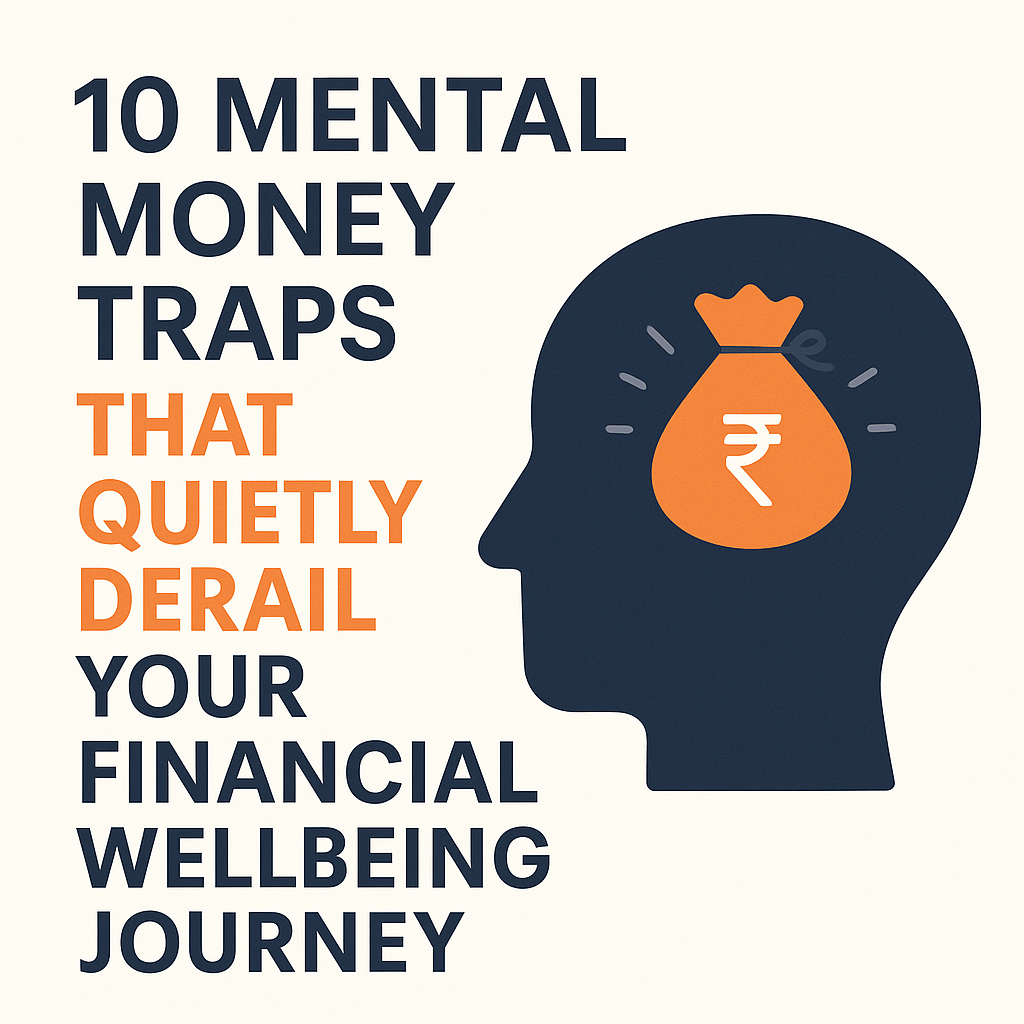Blogs
Investment101: 10 Money Mistakes That Sabotage Your Wealth-Building Journey
Most of us genuinely want to make smart money decisions — to save, invest, grow our wealth, and secure our future goals. Yet, despite the best intentions, we often delay investments, chase hot tips, or react emotionally to market swings.
It’s not because we lack discipline or financial knowledge — it’s how our brain works. Our investing decisions are shaped by emotions and mental shortcuts we’ve built over time — often without even knowing it. These patterns are what experts call behavioural biases. You don’t need to remember the term, but you’ve probably felt the effects — that tug-of-war between what you should do and what you actually end up doing.
In this blog, we’ll explore 10 common investing habits that quietly derail progress — and how to gently course-correct.
How We Process Information?
.
1. Getting Stuck on the First Price (aka Anchoring Bias)
We often get attached to the first price we see — like buying a stock at ₹1000 and holding on, hoping it bounces back from ₹700. Our brain fixates on that initial number, influencing future decisions. It’s like seeing a ₹1000 shirt for ₹700 and feeling it’s a bargain just because of the original tag.
What’s at Stake: This can cloud judgment, keeping us stuck in the past and out of touch with current realities. We may wait endlessly for break-even moments and miss better opportunities.
How to Handle It: Focus on the present value and ask: “Would we buy this today at this price?”
2. Only Listening to What We Already Believe (aka Confirmation Bias)
We all like to be right. We naturally seek information that supports what we already believe and ignore anything that challenges it. If we think equity is risky, we’ll focus on stories that confirm our fear and dismiss long-term data. It’s like googling symptoms just to prove our own diagnosis.
What’s at Stake: This narrows our thinking and can trap us with a limited set of strategies, even when better alternatives exist.
How to Handle It: Always ask, “What am I missing?” or “What would someone who disagrees say?” Fresh perspectives often lead to better choices.
3. Thinking Recent Events Will Repeat (aka Recency Bias)
Our brains are wired to focus on what’s happening now and assume it’ll continue. So, when markets rise or fall, we expect the trend to last. We overreact to recent news and ignore the bigger picture. That’s why investors often buy high and sell low — chasing trends instead of staying steady. It’s like thinking every rainy day means a monsoon.
What’s at Stake: Reacting to recent performance can lead to impulsive moves that don’t align with long-term goals.
How to Handle It: Step back. Look at long-term data and remember — today is just one chapter in a bigger story.
How We See Ourselves?
.
4. Feeling Too Sure of Ourselves (aka Overconfidence Bias)
A few good calls — a stock that soared or a mutual fund that outperformed — and we start believing we’ve cracked the code. Overconfidence creeps in, we ignore advice, take bigger risks, and assume we’re always right. But markets don’t reward ego. It’s like feeling invincible after one good gym session.
What’s at Stake: Overconfidence can lead to excessive trading, risky bets, and ignoring diversification — all of which hurt long-term results.
How to Handle It: Build a plan during calm times — and stick to it, especially when we feel tempted to “outsmart” the market.
5. Always Right… or Never to Blame? (aka Self-Serving Bias)
When investments rise, we feel smart. When they fall, we blame the market, the advisor, or the government. This selective memory protects our ego but blocks growth. It’s like cheering when our team wins but blaming the umpire when they lose.
What’s at Stake: Without honest reflection, we miss the chance to see what’s truly working — and what’s not. That limits our growth as investors.
How to Handle It: Keep brief notes on why we invested. When we review them later, patterns emerge. And when in doubt, talk to someone we trust.
6. Saying “I Knew It!” After It Happens (aka Hindsight Bias)
After a market move, we often say, “I knew this would happen.” But we rarely did. This illusion of foresight builds false confidence, encourages risky bets, and distorts our memory. It’s like claiming we saw the plot twist coming — after the movie ends.
What’s at Stake: Believing outcomes were obvious makes us underestimate future uncertainty and misjudge risk.
How to Handle It: Let’s stay humble. We can’t predict the future, but we can prepare for it — with a clear plan and the right mix of investments.
How Emotions Interfere with Money?
.
7. Fearing Losses More Than We Enjoy Gains (aka Loss Aversion Bias)
We feel the pain of a ₹1000 loss more intensely than the joy of a ₹1000 gain. That’s why we hold poor investments — not wanting to “lock in” a loss — or avoid equity altogether. It’s fear pretending to be caution. Like skipping the gym forever because we once had sore muscles.
What’s at Stake: This fear can make us miss long-term growth or stay stuck with underperformers just to avoid admitting defeat.
How to Handle It: Reframe investing as a way to reach life goals. Focus on the bigger picture. Volatility is part of the journey — not a problem.
8. Choosing Today’s Comfort Over Tomorrow’s Benefit (aka Present Bias)
Spending today feels good, so skipping a SIP for shopping or travel seems harmless — but it quietly steals time from our future goals. We often forget how costly delays can be. It’s like indulging daily and wondering why we’re not losing weight.
What’s at Stake: Delaying investments means losing time — the most powerful ingredient in compounding.
How to Handle It: Treat investing like a non-negotiable monthly expense. Automate it — so willpower isn’t part of the equation.
How We React to Others?
.
9. Following the Crowd (aka Herd Mentality)
We feel safer doing what others are doing. If friends or social media say a stock is booming, we feel left out if we don’t join. But what’s popular isn’t always right — especially for our financial goals. It’s like joining a stampede without checking where it’s headed.
What’s at Stake: Herding can trigger emotional decisions that don’t match our risk profile or timelines.
How to Handle It: Stick to our own roadmap. Trends fade — goals don’t.
10. Sticking Only to What Feels Familiar (aka Familiarity Bias)
We prefer what we know — gold, FDs, property. Equity funds may feel risky just because they’re unfamiliar. But familiarity doesn’t equal safety or suitability. It’s like always ordering the same dish — even when better options exist.
What’s at Stake: Avoiding unfamiliar investments can hold us back from building a balanced, growth-focused portfolio.
How to Handle It: Learn gradually. Take small steps outside our comfort zone — with guidance if needed.
7 Habits to Outsmart Your Own Biases: .
.
🚀 Have a Game Plan – A well-defined financial roadmap keeps you grounded when emotions run high or markets wobble. It gives purpose to your money moves.
🚀 Automate with SIPs – Consistent investing through SIPs removes the guesswork and hesitation. You invest without overthinking every month.
🚀 Diversify Smartly – Don’t put all your eggs in one basket. A healthy mix of assets helps protect against sudden shocks and improves long-term outcomes.
🚀 Talk to a Trusted Guide – A qualified personal finance professional can offer clarity, challenge your assumptions, and help you avoid costly emotional decisions.
🚀 Stay Curious, Keep Learning – Even small bits of financial awareness can help you spot your own blind spots and make wiser choices.
🚀 Create a Pause Button – Build in a 24-hour delay before reacting to market noise or financial news. That space gives logic time to step in.
🚀 Review and Rebalance Regularly – Once or twice a year, check if your investments still match your goals. Small adjustments go a long way toward staying on track.
Conclusion:
.
You don’t need to be perfect with your money. But being aware of your biases — and putting small, smart habits in place — can make all the difference.
After all, investing isn’t just about managing money. It’s about managing how we think and feel about money. With self-awareness, a steady plan, and the willingness to pause, you can make more thoughtful choices — and move steadily toward the life you’re planning for.
Note: This blog is for educational purposes only and should not be treated as financial advice.
#trupointValueServices #BehaviouralBiases #MentalMoneyTraps #MoneyMistakes #InvestSmart #FinancialWellbeing #BehaviouralFinance #SmartInvesting






